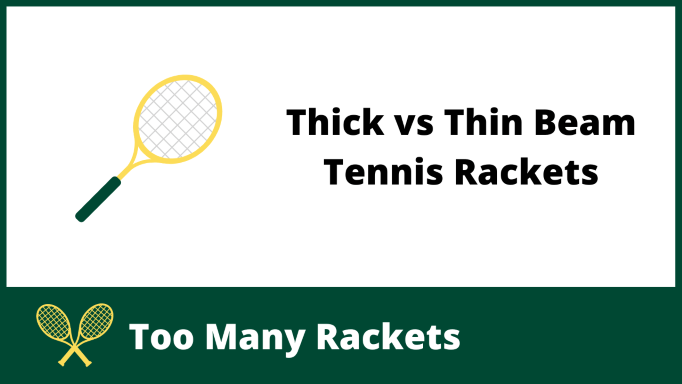The beam width of a tennis racket plays an important role in its playability but it is often overlooked by recreational players when they are buying a new frame.
This article will look at what the beam width of a racket is and at the pros and cons of using a frame with a thick or thin beam width.

Beam Width
The beam width of a racket refers to the thickness of the frame at three different points: Head, Side, and Throat.
They generally range from 18mm to 28mm with widths under 23mm considered thin and widths over 23mm considered thick.
An example of a thin beam would be the Wilson Pro Staff RF97 Autograph which is 21.5mm wide while an example of a thick beam would be the Wilson Clash 100 which is 24.5mm wide.
Thick vs Thin Beam Width
Below I will look at the pros and cons of thick and thin beam rackets so that you can get a better idea as to which may suit your game better.
Pros and Cons of Thick Beams
The main pro is that it is easier to generate power on your shots, which makes them ideal for beginner to intermediate players.
They are also a bit more forgiving as they usually have a bigger head size and a larger sweet spot.
The main con is that the extra power you get comes at the cost of control so if you are more of an advanced player then you may have a tendency to overhit your shots.
Another con is that they tend to be stiff so they may cause arm issues or tennis elbow.
Pros and Cons of Thin Beams
The main pros are that you get more touch, feel, and control on your shots.
They also tend to have flexible frames with a stiffness rating in the 55-65 range so they are a good option if you have had tennis elbow in the past.
The only real con is that they are usually low powered frames so you will need a full and fast swing with good technique if you want to hit your shots with power.
Recommendations
If you are a beginner to an intermediate player then I think a racket with a thicker beam e.g. Wilson Clash 100 is the better option for you as the extra power you get on your serve and groundstrokes will do more for your game than having a racket that gives you more control.
However, once you develop into more of an advanced player then it is likely you will want a racket that gives you less power and more control so you are likely to switch to a frame with a thinner width.
My recommendations for advanced players would be the Wilson Pro Staff 97, Head Gravity Pro, and the Yonex Vcore Pro 97.
As always, I would recommend that you demo any tennis racket before making your final buying decision.